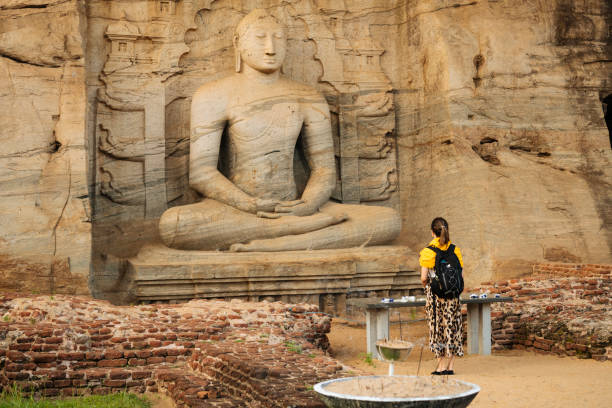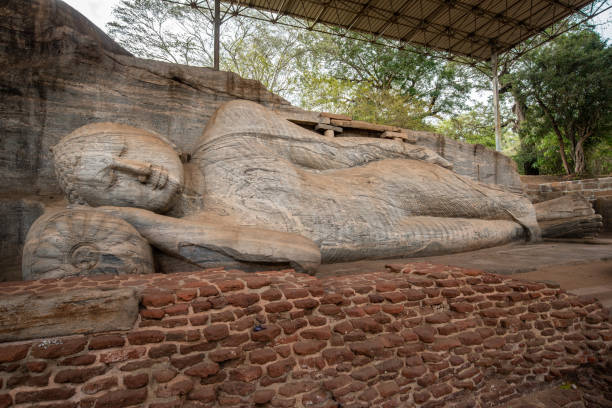Gal Viharaya Buddha statues sit among the finest stone carvings made in Sri Lankan history. The fine carvings were built under the reign of King Parakramabahu I during the 12th century. The complex has four carvings of Buddha. From left to right “Seated Figure”, “Nisinnapatima Guha”, “Standing Figure”, “Reclining Figure”
Seated Figure (Vidyadhara Guha)

The sculpture depicts the common meditation posture known as Samadhi Mudra or Dhyana Mudra with both hands placed on the lap, right palm on the left palm, and seated on a throne decorated with lions, and Vajras. Behind the head is an arch shaped “thorana” with two pillars running down with dragon faces holding small lions in their months, and on the top has four smaller meditation Buddha figures.
Historians suggest that this sculpture is of the Mahayana tradition and could be a Vairocana, the supreme Buddha.
Nisinnapatima Guha (second image from left)
Nisinnapatima Guha in Pali means the extended cave. This could be a cave within the stone slab extended, to house the stone carved seated Buddha sculpture depicting the Samadhi or Dhyana Mudra. A halo or “prabhamandala” is carved behind the head of the sculpture. The throne is decorated with Vajras and lions, and there are deity figures on each side of the head and two deity figures with fly-whisks. It is believed that the top deity figures are of Maha Brahma and Vishnu. It is believed that this sculpture depicts the Buddha’s visit to the heavenly realm Thawthisa.
Standing Figure (Utthitapatima Guha)
A seven meter tall stone sculpture with two controversial theories of its identity. Some believe that it is a sculpture of the Buddha and some believe it is of the Adanada Thero.
One of the ten principal disciples Ananda Thero was the primary attendant of Buddha, it is believed that this is a statue of saddened Ananda thero mourning beside the reclining Buddha which represent the mahaparinirvana.
The other theory is that this is a statue of the Buddha with crossed hands on his chest in grief, sorrowing for the sorrowing of others. The swollen left foot of the sculpture says that it could be a sculpture of the Buddha just before the mahaparinirvana, thinking about the sorrows of others or whom he can help to reach enlightenment.
There is another theory which says that this is a statue of the Buddha in his second week after attaining enlightenment, looking at the world with Maha Karua or the compassion towards all living beings.
Reclining Figure (Nipannapatima Guha)

A fourteen meter long reclining Buddha statue depicts the Mahaparinirvana. The statue has fine details. Lotus flowers offered were kept on the palm and the feet. The upper foot had slightly fallen back. The left earlobe or the upper earlobe has fallen down on the face, and the chest was shrinked. If you take a look from feet the robe was perfectly folded and kept as if it was done by someone else. All the elements denote that the sculpture depicts the Mahaparinirvana.
You will be expected to wear appropriate clothing when visiting, and will have to walk bare footed. Socks can come in handy if to walk on the blistering hot grounds.
- {{ listing.node.ViewsText }}
- {{ listing.node.FavsText }}
- {{ listing.node.ThumbsText }}
Things to do near Gal Viharaya
Explore More

{{ listing.node.Title }}
- {{ listing.node.ViewsText }}
- {{ listing.node.FavsText }}
- {{ listing.node.ThumbsText }}
Places to eat near Gal Viharaya
Explore More

{{ listing.node.Title }}
- {{ listing.node.ViewsText }}
- {{ listing.node.FavsText }}
- {{ listing.node.ThumbsText }}
Places to stay near Gal Viharaya
Explore More





